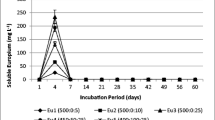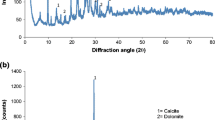Abstract
In this study, two mixtures of municipal compost, limestone and, optionally, zero-valent iron were assessed in two column experiments on acid mine treatment. The effluent solution was systematically analysed throughout the experiment and precipitates from both columns were withdrawn for scanning electron microscopy, energy-dispersive X-ray spectroscopy, X-ray diffractometry analysis and, from the column containing zero-valent iron, solid digestion and sequential extraction analysis. The results showed that waters were cleaned of arsenic, metals and acidity, but chemical and morphological analysis suggested that metal removal was not due predominantly to biogenic sulphide generation but to pH increase, i.e. metal (oxy)hydroxide and carbonate precipitation. Retained arsenic and metal removal were clearly associated to co-precipitation with and/or sorption on iron and aluminum (oxy)hydroxides. An improvement on the arsenic removal efficiency was achieved when the filling mixture contained zero-valent iron. Values of arsenic concentrations were then always below 10 μg/L.


Similar content being viewed by others
References
Beak, D. G., & Wilkin, R. T. (2009). Performance of a zerovalent iron reactive barrier for the treatment of arsenic in groundwater: Part 2. Geochemical modeling and solid phase studies. Journal of Contaminant Hydrology, 106, 15–28.
Blowes, D. W., Ptacek, C. J., Benner, S. G., McRae, C. W. T., Bennett, T. A., & Puls, R. W. (2000). Treatment of inorganic contaminants using permeable reactive barriers. Journal of Contaminant Hydrology, 45, 123–137.
Brammer, H., & Ravenscroft, P. (2009). Arsenic in groundwater: A threat to sustainable agriculture in South and South-east Asia. Environment International, 35, 647–654.
Burghardt, D., Simon, E., Knöller, K., & Kassahun, A. (2007). Immobilization of uranium and arsenic by injectible iron and hydrogen stimulated autotrophic sulphate reduction. Journal of Contaminant Hydrology, 94, 305–314.
Davidson, C. M., Duncan, A. L., Littlejohn, D., Ure, A. M., & Garden, L. M. (1998). A critical evaluation of the three-stage BCR sequential extraction procedure to assess the potential mobility and toxicity of heavy metals in industrially-contaminated land. Analytica Chimica Acta, 363, 45–55.
Gibert, O., de Pablo, J., Cortina, J. L., & Ayora, C. (2004). Chemical characterisation of natural organic substrates for biological mitigation of acid mine drainage. Water Research, 38, 4186–4196.
Hammack, R. W., Edenborn, H. M., & Dvorak, D. H. (1994). Treatment of water from an open-pit copper mine using biogenic sulfide and limestone: a feasibility study. Water Research, 28, 2321–2329.
Herbert, R. B., Benner, S. G., & Blowes, D. W. (2000). Solid phase iron-sulfur geochemistry of a reactive barrier for treatment of mine drainage. Applied Geochemistry, 15, 1331–1343.
Lien, H. L., & Wilkin, R. T. (2005). High-level arsenite removal from groundwater by zero-valent iron. Chemosphere, 59, 377–386.
Ludwig, R. D., Smyth, D. J. A., Blowes, D. W., Spink, L. E., Wilkin, R. T., Jewett, D. G., et al. (2009). Treatment of arsenic, heavy metals, and acidity using a mixed ZVI-compost PRB. Environmental Science and Technology, 43, 1970–1976.
Roh, Y., Lee, S. Y., & Elless, M. P. (2000). Characterization of corrosion products in the permeable reactive barriers. Environmental Geology, 40, 184–194.
Su, C., & Puls, R. W. (2003). In situ remediation of arsenic in simulated groundwater using zerovalent iron: Laboratory column tests on combined effects of phosphate and silicate. Environmental Science and Technology, 37, 2582–2587.
Triszcz, J. M., Porta, A., & García Einschlag, F. S. (2009). Effect of operating conditions on iron corrosion rates in zero-valent iron systems for arsenic removal. Chemical Engineering Journal, 150, 431–439.
Tyrovola, K., & Nikolaidis, N. P. (2009). Arsenic mobility and stabilization in topsoils. Water Research, 43, 1589–1596.
Waybrant, K. R., Blowes, D. W., & Ptacek, C. J. (1998). Selection of reactive mixtures for use in permeable reactive walls for treatment of mine drainage. Environmental Science and Technology, 32, 1972–1979.
Wilkin, R. T., Acree, S. D., Ross, R. R., Beak, D. G., & Lee, T. R. (2009). Performance of a zerovalent iron reactive barrier for the treatment of arsenic in groundwater: Part 1. Hydrogeochemical studies. Journal of Contaminant Hydrology, 106, 1–14.
Younger, P. L., Banwart, S. A., & Hedin, R. S. (2002). Mine Water: Hydrology, Pollution, Remediation (1st ed.). Dordrecht: Kluwer Academic Publishers.
Zouboulis, A. I., & Katsoyiannis, I. A. (2005). Recent advances in the bioremediation of arsenic-contaminated groundwater. Environment International, 31, 213–219.
Acknowledgements
We gratefully acknowledge M. Marsal (Laboratory of Electronic Microscopy, Universitat Politècnica de Catalunya) for the scanning electron microscopy (SEM) analysis. We also thank Connelly-GPM (Chicago, IL, USA) for providing the iron aggregates.
Author information
Authors and Affiliations
Corresponding author
Rights and permissions
About this article
Cite this article
Gibert, O., de Pablo, J., Cortina, JL. et al. In situ removal of arsenic from groundwater by using permeable reactive barriers of organic matter/limestone/zero-valent iron mixtures. Environ Geochem Health 32, 373–378 (2010). https://doi.org/10.1007/s10653-010-9290-1
Received:
Accepted:
Published:
Issue Date:
DOI: https://doi.org/10.1007/s10653-010-9290-1




